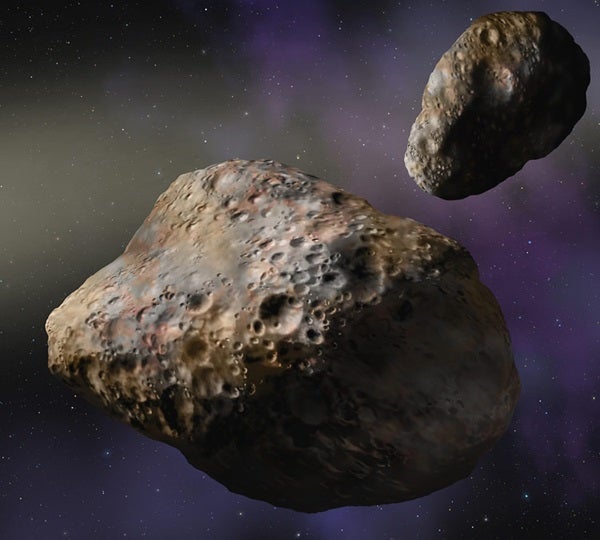Astronomers using the 10-meter Keck II Telescope on Hawaii’s Mauna Kea have refined the mutual orbit of asteroid 617 Patroclus and its companion. The pair is the only known binary object among the 1,900 asteroids the giant planet Jupiter shepherds around the Sun.
Once astronomer Franck Marchis at the University of California, Berkeley, and his colleagues modeled the orbit, they could determine the density of the two asteroids. These asteroids, they say, have densities closer to those of comets than rocks. Patroclus and its companion, provisionally named Menoetius, are less dense than water, which means they’re probably made of water ice and coated with a patina of dirt.
“It’s our suspicion that the Trojans are small Kuiper Belt objects,” says Marchis.
Trojan asteroids are those that lead or follow Jupiter by 60° in its orbit around the Sun. The gravity of Jupiter and the Sun balance at these locations, allowing objects to accumulate there. According to the Minor Planet Center in Cambridge, Massachusetts, astronomers have cataloged about 1,900 of these space rocks. They are relatively small and faint, which makes them difficult to study even with the world’s largest ground-based telescopes.
Astronomers found Patroclus in 1906. In October 2001, William Merline at the Southwest Research Institute in Boulder, Colorado, and his colleagues found its companion, but their observations weren’t detailed enough to determine the components’ orbit.
Marchis observed the pair using the Keck II Telescope’s Near-Infrared Camera (NIRC2) in November 2004 and May 2005. At the same time, Keck Observatory astronomers were commissioning a new adaptive-optics system that uses a sodium laser to create an artificial star. Monitoring the laser’s star helps the telescope adapt to the blurring effects of Earth’s atmosphere.
“Before, we could only look at objects near a bright reference star, limiting the use of adaptive optics to a small percentage of the heavens,” Marchis says. “Now, we can use adaptive optics to view almost any point on the sky.” The system produced images clear enough to estimate the mutual orbit of Patroclus and its kin.
Patroclus is about 76 miles (122 km) wide, while Menoetius is slightly smaller (70 miles, or 112 km). The two objects are separated by 423 miles (680 km) and circle their common center of mass every 4.3 days. The team calculates both objects have densities as low as 0.8 gram per cubic centimeter — light enough to float in water. Both asteroids are named for heroes of Homer’s Iliad, a tale of the Trojan War. Patroclus was named for Achilles’ best friend; Menoetius was Patroclus’ father.
“This is the first time anyone has determined directly the density of a Trojan asteroid,” says team member Daniel Hestroffer, an astronomer at the Paris Observatory’s Institute of Celestial Mechanics and Ephemerides Calculation.
The measurement appears to validate an idea put forward last year by Côte d’Azur Observatory’s Alessandro Morbidelli and his coworkers. Morbidelli’s team suspects Trojan asteroids formed in the Kuiper Belt beyond Neptune.
Computer simulations suggest the giant gas planets — Jupiter through Neptune — migrated outward less than 1 billion years after they formed. A dense disk of icy planetesimals orbited at the edge of the planetary system; its remnant is today’s Kuiper Belt. The presence of this massive disk forced the gas giants to move outward.
When Saturn and Jupiter moved far enough outward that Jupiter orbited twice for every revolution of Saturn, drastic changes ensued. Uranus and Neptune careened into the disk, where they stirred up planetesimal orbits. Some of these small objects shot toward the Sun, perhaps creating the devastating round of impacts astronomers call the Late Heavy Bombardment. Others were ejected from the solar system altogether, or formed the Kuiper Belt we see today.
Jupiter couldn’t retain its Trojan asteroids during that event, says Morbidelli. But once its 2:1 relationship with Saturn ended and things settled down, any icy objects in Jupiter’s vicinity were trapped. Later, Patroclus may have split in two after a too-close pass with the giant planet.
“We need to discover more binary Trojans and observe them to see if low density is a characteristic of all Trojans,” Marchis cautions. If it is, objects from the Kuiper Belt may be more accessible than scientists ever suspected.










